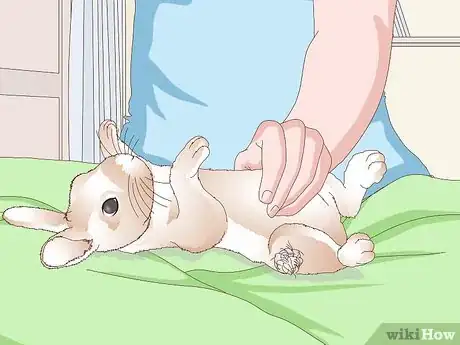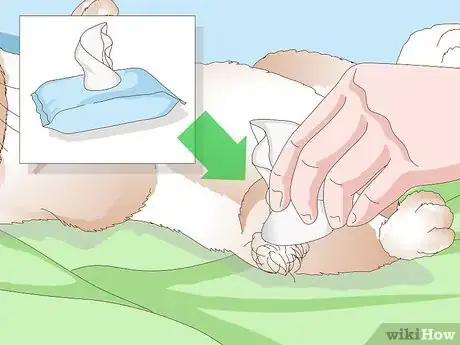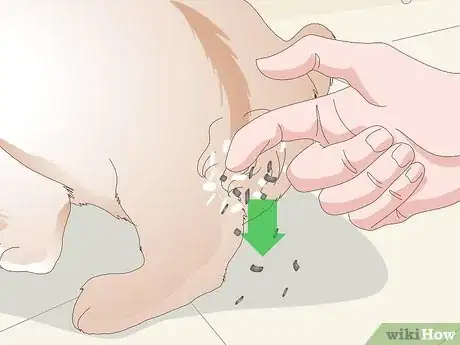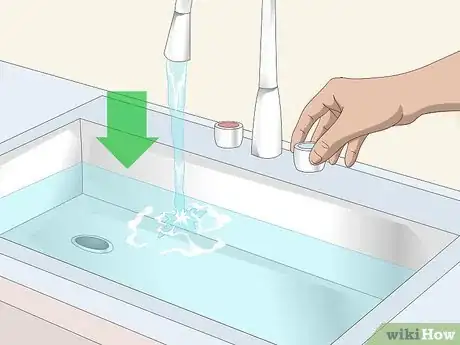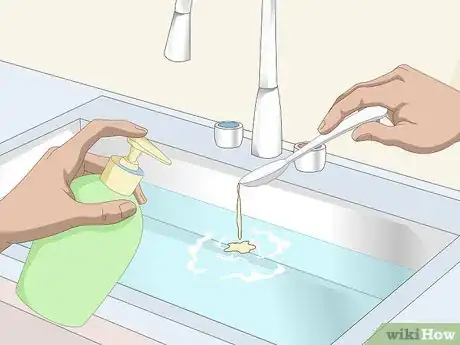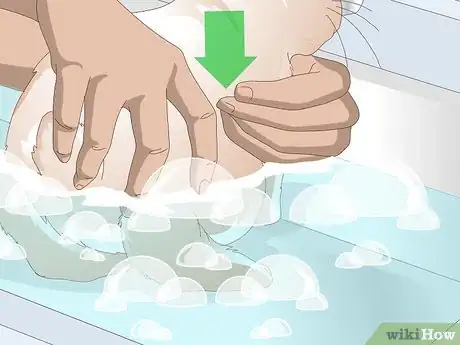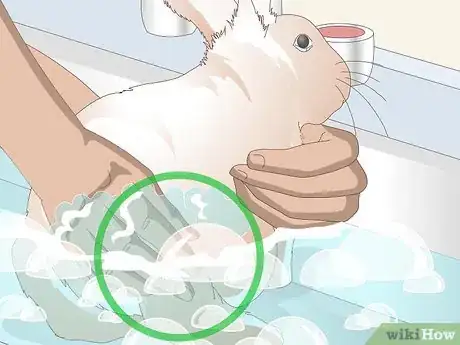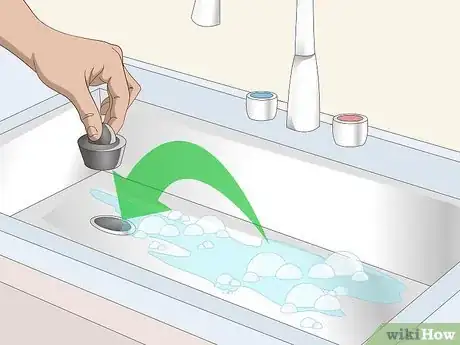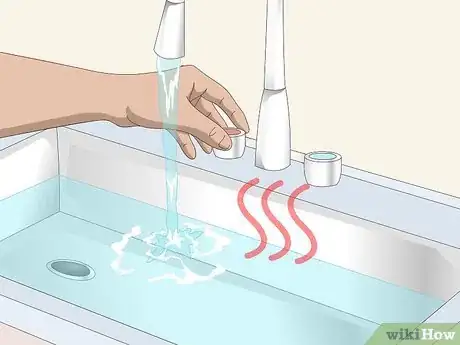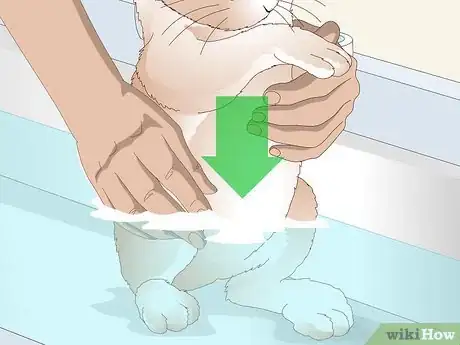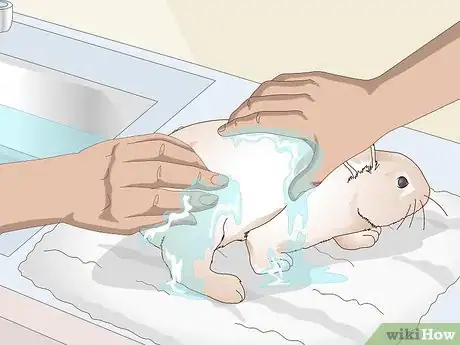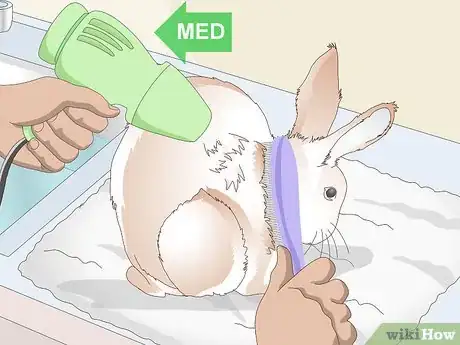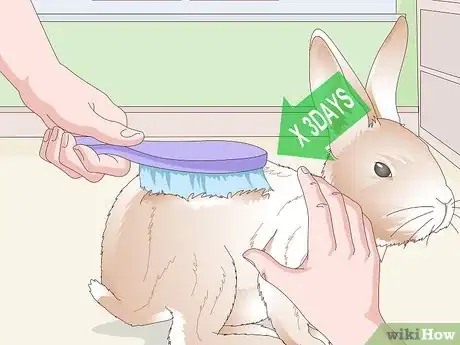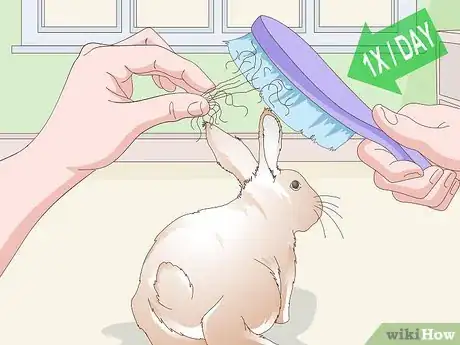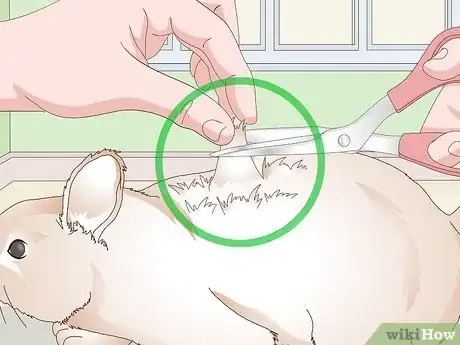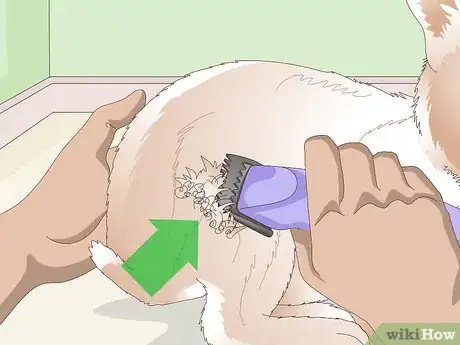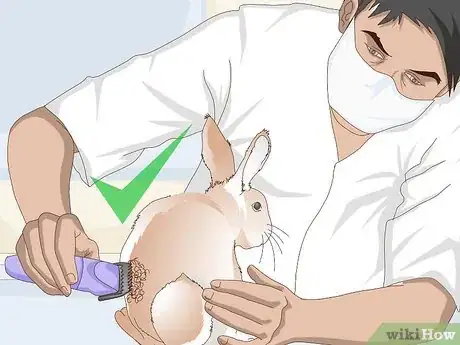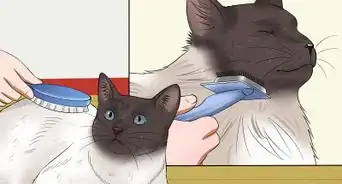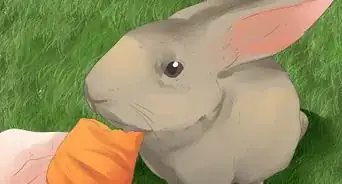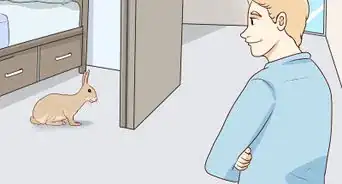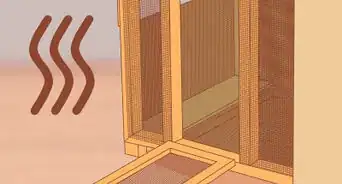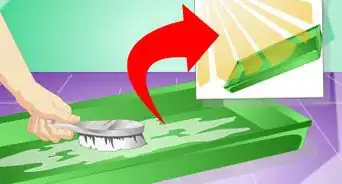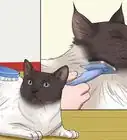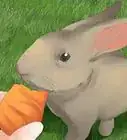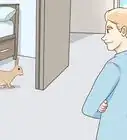This article was co-authored by Pippa Elliott, MRCVS. Dr. Elliott, BVMS, MRCVS is a veterinarian with over 30 years of experience in veterinary surgery and companion animal practice. She graduated from the University of Glasgow in 1987 with a degree in veterinary medicine and surgery. She has worked at the same animal clinic in her hometown for over 20 years.
There are 7 references cited in this article, which can be found at the bottom of the page.
This article has been viewed 73,409 times.
Rabbits, like cats, are self-cleaners and will generally keep their coats clean by licking themselves. However, your rabbit needs your help grooming as well, especially if you have a long-haired breed. While your first instinct may be to give your rabbit a bath, bathing your rabbit in water can be very stressful for it and dangerous to its health. However, by spot-cleaning your rabbit’s fur, giving it a dry bath from time to time, and learning how to properly prevent and remove mats and tangles from its fur, you can keep your rabbit clean, healthy, and happy.
Steps
Spot-Cleaning Your Rabbit’s Fur
-
1Identify any soiled areas. Spot-cleaning your rabbit is the recommended method for keeping its coat clean. The first thing you’ll need to do is identify any areas of its coat that are dirty. In general, a rabbit’s problem areas are their backside, tail, feet, and belly because these are all places they may be unable to reach easily on their own. Look for dirt, food, and feces stains, as well as wet spots, which are often urine.[1]
-
2Hold your rabbit so its problem areas are easily reached. Once you have identified any soiled spots on your rabbit’s coat, place your rabbit in a position that is both comfortable for them and that makes it easy for you to reach the soiled areas.
- Most of the time, you will need to position your rabbit on its back. To do so, either hold your rabbit belly-up in one arm or sit on the floor with your legs outstretched and lay your bunny belly-up on top of your legs. Make sure you are able to hold your rabbit securely in whichever position you choose.
- If the soiled area is on your bunny’s back or sides, you can simply lay a towel out on the floor or a large table and sit your rabbit on its feet to clean its fur.[2]
- Ensure your rabbit’s back is cushioned and its neck and back are supported in whichever position you put it. This will help prevent any injuries.[3]
Advertisement -
3Remove stains with a baby wipe. Now that you have your rabbit in a position that lets you easily access the stains on its fur, gently rub the fur and skin with a baby wipe to remove any dirt, food, feces, or urine. After you have targeted all the soiled areas, give your rabbit an all-over wipe-down with a clean wipe.
- Look for baby wipes that are fragrance-free, alcohol-free, and hypo-allergenic. In addition, choose one that contains aloe and Vitamin E. These will be gentle on your rabbit’s sensitive skin.[4]
Giving Your Rabbit a Dry Bath
-
1Apply baby cornstarch powder. You may not be able to remove dried-on messes, like mud or your rabbit’s droppings, by spot-cleaning with a baby wipe. Giving your rabbit a dry bath can help take care of these stubborn, dried-on messes. The first step in giving your rabbit a dry bath is to sprinkle baby cornstarch powder liberally over these areas.[5]
- Do not use a baby powder that contains talc, or talcum powder. This can be harmful to rabbits.[6]
-
2Work the powder around the soiled area. Use your fingers to work the powder around the soiled area, into the fur and down to the skin. Coating these messes with powder should allow them to break free from the fur and slide off.
-
3Slide the debris out of the fur. Use your fingers to gently pull down on the dried debris, removing it from your rabbit’s coat. Rabbit skin is surprisingly delicate, so keep your hand pressed against your rabbit’s skin at the top of the soiled area to keep from tearing it.
- For especially stubborn messes, use a fine-toothed comb to gently work the debris out of the fur after you’ve applied the cornstarch powder. To do so, start at the top of the stain (closest to the skin) and lightly tease the dirt away from the skin. Place your hand on your rabbit’s skin to keep from pulling too hard.[7]
-
4Pat the powdered areas. Use your hand to pat down the powdered areas to remove any remaining cornstarch. In addition, use a hand-held vacuum to vacuum the air around your bunny to remove any powder from the air and keep your bunny from ingesting it.[8]
- You can also use a soft wash cloth or microfiber cloth to clean any remaining powder from your rabbit.[9]
Giving Your Rabbit a Butt Bath
-
1Fill the sink. If your bunny is particularly soiled, you can give it a “butt bath.” This is a wet bath that focuses mostly on their backside and belly (if needed). Wet baths can be very stressful for rabbits, however, so do this only in situations where spot-cleaning and a dry bath didn’t work. First, fill a clean bathroom or kitchen sink with approximately 2 ½ inches of warm water.[10]
- It may be helpful to use a sink that has a hose attachment for rinsing.
- You can also use a small kitty litter tub, a baby bath, or even a slanted paint pan. Use whichever works best for you and your rabbit.
- Place a non-slip mat on the bottom of your sink, tub, or pan. This will help keep your rabbit from slipping on the smooth, wet surface.[11]
-
2Mix shampoo into the water. Next, add a tablespoon of rabbit-safe shampoo to your water and mix it well. Rabbits have extremely sensitive skin so using a shampoo made specifically for bunnies is important.[12]
-
3Hold your rabbit. Wrap one arm around your bunny, underneath its elbows, and hold it firmly so that its head and shoulders are pressed against your chest. Use your other hand to hold underneath your rabbit’s back legs.
- It is important that you are gentle, but firm when holding your bunny. You need to make sure it isn’t able to twist or wiggle too much. Pay attention to its actions to make sure you’re not hurting it.[13]
-
4Place your rabbit’s hind legs in the bath. Lower your bunny’s hind end into the sink until its back feet touch the bottom. At this point you can remove your hand from underneath its back legs.[14]
-
5Work shampoo through your rabbit’s fur. Use one hand to gently rub your bunny’s hind end and belly with the soapy water. Work the shampoo through its fur and down to the skin.
- Do not wet above your rabbits belly unless absolutely necessary, as this will be extra stressful for it.
- If your bunny is especially dirty, you may have to drain and refill your sink with fresh soapy water a few times to get them completely clean. [15]
-
6Drain your sink. Once the soiled areas of your rabbit are clean, drain the soapy water from your sink and rinse any residual shampoo from it.[16]
-
7Fill your sink with clean water. Next, fill your sink with clean, warm water to rinse the shampoo from your rabbit’s fur.[17]
-
8Lower your bunny into the clean water. At this point, lower your rabbit’s back end into the clean water. Use your hand to gently rub its fur in order to remove the shampoo from it.
- You may have to empty and refill your sink multiple times to get all of the shampoo residue out of your pet’s fur. Do this until the water remains clean and shampoo-free.
- You can also use a small hose to rinse the shampoo from your rabbit’s fur.[18]
-
9Dry your rabbit. Lift your rabbit out of the bath and place them on a towel or other soft surface where it will have some traction. Using your hands, gently wring the water out of your rabbit’s fur as best you can. Gently pat or rub your rabbit with a towel to get additional water out of its coat.
-
10Use a hairdryer to finish drying. Finish drying your rabbit’s fur with a hairdryer. Use the dryer on a medium-warm setting, never hot. Hold the blow dryer at least six inches away from your rabbit at all times and try to keep your hand near where you are blowing the heat to further monitor the temperature.
- You can use a fine-toothed comb to separate the fur while you’re drying it to speed up the drying process.[21]
Preventing Tangles and Hairballs
-
1Brush your rabbit every two to three days. Like cats, rabbits lick themselves to self-clean. However, unlike cats, rabbits cannot vomit so any hairballs your rabbit ingests will stay in its stomach, blocking the stomach exit and causing serious health issues. Brushing your rabbit regularly can help cut down on the amount of loose fur it ingests, in addition to keeping its fur mat-free. Short-haired rabbits need to be brushed every three days to prevent hairballs and tangles in their fur. Long-haired rabbits should be brushed every day.
- Use a bristle-brush instead of a metal-toothed brush, as this will be gentler on your rabbit’s skin. Look for a brush made specifically for rabbits.
- You can follow up brushing with a rubber grooming tool or another hand-held finishing tool to help get any additional loose hairs. A damp washcloth will also work to remove loose hairs.[22]
- How much your rabbit needs brushed depends on their breed. As a general rule, the longer the hair, the more often you need to brush.[23]
-
2Brush your rabbit daily when it is shedding. Rabbits shed approximately every three months. During this time, you’ll generally need to brush your short-haired rabbit once a day and your long-haired rabbit multiple times a day.
- The rate at which rabbits shed varies. Some rabbits will shed their coats over several weeks, while others shed it all within a few days. Pay attention to the shedding patterns of your rabbit and adjust how often you brush them accordingly. For example, rabbits that shed over the course of several weeks may need brushed only once a day, but rabbits that shed over a few days need to be brushed multiple times per day.[24]
-
3Trim your rabbit’s fur as needed. Short-haired rabbits don’t usually need their fur trimmed, but long-haired rabbits often do. If you have a long-haired rabbit, it is a good idea to keep its hair trimmed to one inch in length. This will help prevent mats and cut down on shedding.
- Don’t trim the hair around your rabbit’s feet. Doing so can cause your rabbit to get sores from a lack of padding.
- It is suggested that you keep the fur on your long-haired rabbit’s belly and between its legs trimmed short or even shaved. This hair is especially vulnerable to mats and tangles.
- You can use either scissors or electric small animal clippers to trim your rabbit’s hair. Be very careful, however, because rabbits’ skin is very delicate and you can easily cause a serious injury if you cut them with the scissors or clippers.
- It is best to have someone help you hold your rabbit still if you choose to trim its fur. If you are trimming its belly, between its legs, or its backside, have one person hold the rabbit straight up and down with its back pressed against the person’s chest. They should have one hand placed under the front legs and the other holding the back legs to prevent the rabbit from kicking and hurting itself.[25]
Removing Mats and Tangles
-
1Break the mat apart. If your rabbit has a mat in its fur, you’ll first want to try and work the mat out using a mat splitter or mat rake. Use these tools to carefully separate the mat, combing it out a tiny section at a time.
- Press your hand on top of the skin at the top of the mat to keep from tearing your rabbit’s skin.
- It may take you several sessions to get the mat out. Be patient and gentle to keep from hurting your bunny.[26]
-
2Shave off difficult mats. If you’re dealing with an especially difficult mat, you may have to shave your rabbit in order to remove it. The most difficult mats to remove are sheet mats, or those that form a solid block in your rabbit’s coat. If you encounter a mat like this, shaving may be your only option. To shave your rabbit, purchase a good pair of clippers that will allow you to have enough control to get into tight spaces.
- Ask your veterinarian or groomer for recommendations on a good pair of clippers.[27]
-
3Go to a professional groomer. Because of the delicate nature of your rabbit’s skin, it might be a good idea to take your bunny to a professional groomer in order to remove any stubborn mats. They will have the right tools and knowledge to get the mats out without cutting or irritating your rabbit’s skin.[28]
Warnings
- Be extremely careful with brushes/combs with wire teeth/bristles. Rabbits have tender skin which is damaged easily.⧼thumbs_response⧽
- Use caution when you are grooming the hair underneath your rabbit’s chin. Most rabbits do not like being touched in this area.⧼thumbs_response⧽
Things You’ll Need
- Baby wipes
- Baby cornstarch powder
- Fine-toothed comb
- Hand-held vacuum
- Wash cloth (optional)
- Sink or tub
- Non-slip mat
- Rabbit shampoo
- Towel
- Hair dryer
- Rabbit brush
- Rubber grooming tool or hand-held finishing tool
- Scissors or electric clippers
- Mat splitter or mat rake
References
- ↑ http://www.mybunny.org/info/rabbit-grooming/
- ↑ http://www.disabledrabbits.com/baths--cleaning.html
- ↑ http://www.bio.miami.edu/hare/buttbath.html
- ↑ http://www.disabledrabbits.com/baths--cleaning.html
- ↑ http://www.bio.miami.edu/hare/buttbath.html
- ↑ http://www.disabledrabbits.com/baths--cleaning.html
- ↑ http://www.bio.miami.edu/hare/buttbath.html
- ↑ http://www.bio.miami.edu/hare/buttbath.html
- ↑ http://www.disabledrabbits.com/baths--cleaning.html
- ↑ http://www.bio.miami.edu/hare/buttbath.html
- ↑ http://www.disabledrabbits.com/baths--cleaning.html
- ↑ http://www.bio.miami.edu/hare/buttbath.html
- ↑ http://www.bio.miami.edu/hare/buttbath.html
- ↑ http://www.bio.miami.edu/hare/buttbath.html
- ↑ http://www.bio.miami.edu/hare/buttbath.html
- ↑ http://www.bio.miami.edu/hare/buttbath.html
- ↑ http://www.bio.miami.edu/hare/buttbath.html
- ↑ http://www.bio.miami.edu/hare/buttbath.html
- ↑ http://www.bio.miami.edu/hare/buttbath.html
- ↑ http://www.disabledrabbits.com/baths--cleaning.html
- ↑ http://www.bio.miami.edu/hare/buttbath.html
- ↑ http://therabbithaven.org/rabbit-grooming-basics
- ↑ http://www.smallanimalchannel.com/rabbits/rabbit-health/rabbit-grooming-guide.aspx
- ↑ http://rabbit.org/faq-grooming/
- ↑ http://www.mybunny.org/info/rabbit-grooming/long-haired/
- ↑ http://www.mybunny.org/info/rabbit-grooming/long-haired/
- ↑ http://therabbithaven.org/rabbit-grooming-basics
- ↑ http://therabbithaven.org/rabbit-grooming-basics
About This Article
To keep your rabbit's fur clean and untangled, regularly spot-clean it by keeping an eye on problem areas like its backside, tail, feet, and belly. Since you should never fully bathe your rabbit in water, opt instead to clean any dirty spots you find with alcohol-free, hypoallergenic baby wipes. For a deeper clean, find a baby cornstarch powder that doesn't contain talc or talcum powder, which can harm rabbits, and work a little bit of it into your rabbit's dirty fur with your hands until you can brush the debris away. If you notice your rabbit's fur has matted at all, you can break the mat apart by combing it out in tiny sections with a mat splitter or by hiring a groomer to shave it off. For more advice from our Veterinary co-author, like how to prevent future tangles and hairballs from your rabbit's fur, read on!

